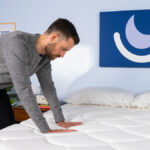There’s no such thing as a perfect mattress, but some models perform better than others when it comes to things like durability, pressure relief, temperature control, and overall support. To select our top mattress picks of the year, we reached out to sleepers like you to find out what worked best for them while personally testing hundreds of mattresses in our test lab with those criteria in mind.
Our Top Picks
-
Best Mattress Overall
–
Helix Midnight
View Details
-
Most Comfortable Mattress
–
Luxury Firm WinkBed
View Details
-
Best Value Mattress
–
DreamCloud Mattress
View Details
-
Best Luxury Mattress
–
Saatva Classic
View Details
-
Best Mattress for Side Sleepers
–
Nolah Evolution 15
View Details
-
Best Mattress for Couples
–
Brooklyn Bedding Signature Hybrid
View Details
-
Best Mattress for Back Pain
–
Bear Elite Hybrid
View Details
-
Best Mattress for Hot Sleepers
–
PlushBeds Botanical Bliss
View Details
-
Best Mattress for Combination Sleepers
–
Nest Bedding Sparrow
View Details
-
Best Eco-Friendly Mattress
–
Avocado Eco Organic Mattress
View Details
Swipe for more
Best Mattress Overall
Helix Midnight
Up to 30% off + 2 free pillows
Up to 30% off + 2 free pillows
The Helix Midnight may be intended for side sleepers between 130 and 230 pounds, but its medium firm hybrid construction makes the mattress suitable for a wide range of sleeper types. Consistent cooling and sturdy edge support add to the appealing design, and an approachable sticker price makes it a solid choice for shoppers with tight budgets.
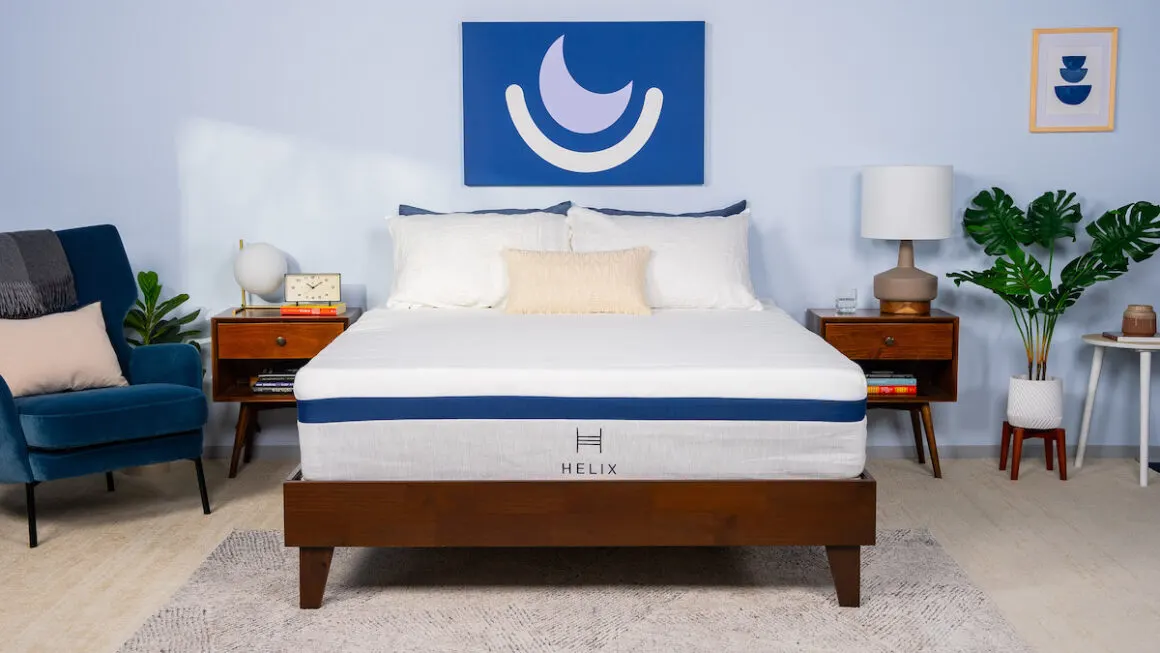

Ideal For
Combination Sleepers
Firmness
Medium Firm (6)
Feel
Close-Conforming Foam
Value
Great Value
Pros & Cons

-
Pros
-
Adaptive foam layers contour evenly without too much hug
-
Zoned perimeter coils limit sinkage when you sleep close to the edges
-
Below-average pricing for a hybrid model
-
-
Cons
-
May lack support for back and stomach sleepers over 230 pounds
-
High potential for strong off-gassing odor after the mattress is unboxed
-
Our Take

Why We Like It
Gentle contouring from the Midnight’s foam layers means most sleepers receive adequate cushioning without the deep “hug” that can occur with soft memory foam, and the coils give the surface an inviting bounce when you get in and out of bed. This responsiveness helps you change sleep positions easily and move across the mattress.
Standout Feature
Temperature control is a defining quality of the Helix Midnight. Air circulates throughout the coil system to maintain a comfortable interior temperature for the mattress, while a breathable cover offsets heat retention from the foam layers. You can upgrade to a cooling cover made of phase change fabric if you tend to sleep excessively hot or sweat during the night.
The Midnight’s comfort system consists of a memory foam top layer over dense transitional polyfoam. These materials conform to your figure and alleviate pain and pressure in sensitive areas, but uncomfortable sinkage shouldn’t be an issue — especially if you primarily use the side or back sleep positions. Thick pocketed coils create a strong support system and add springiness to the surface.
Sleeper Type Ratings

The ratings below indicate how suitable this mattress is for different sleeping positions and sleeper weights, taking into account factors such as support and pressure relief.
Most Comfortable Mattress
Luxury Firm WinkBed
Get $300 off all mattresses at Winkbeds
Get $300 off all mattresses at Winkbeds
Of the WinkBed’s four firmness levels, our testing team has determined the Luxury Firm design offers the broadest appeal across different body types and sleep positions. Adaptive foam layers and zoned coils deliver a comfortable balance of cushioning, support, and responsiveness.
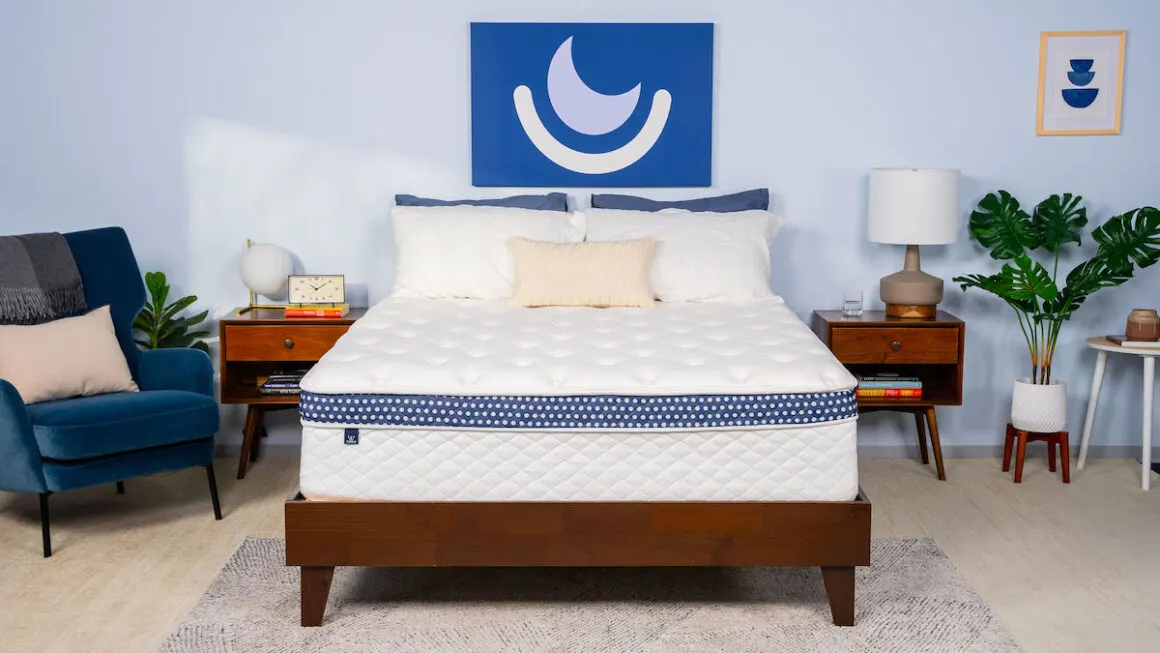

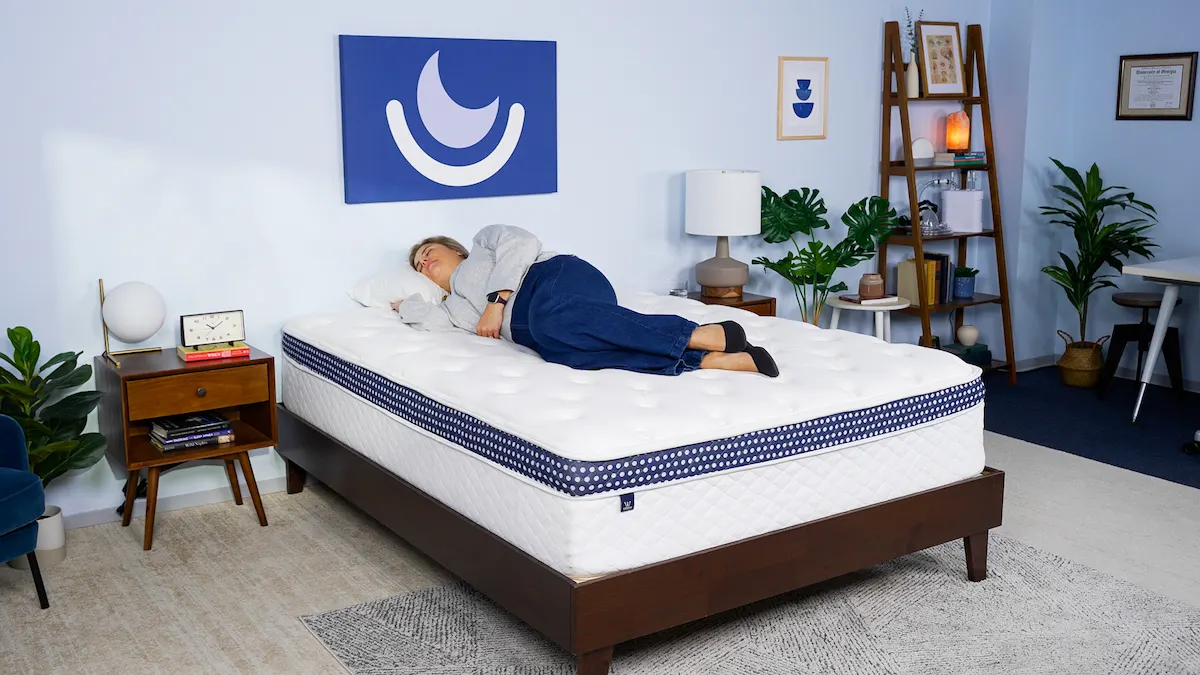
Ideal For
Couples
Firmness
Medium Firm (6)
Feel
Plush, Supportive Surface
Value
Good Value
Pros & Cons

-
Pros
-
Thick foam layers contour evenly while maintaining even support
-
Perimeter feels exceptionally sturdy thanks to a zoned coil system
-
Great cooling from the breathable cover and steady airflow in the coil layer
-
-
Cons
-
Too firm for some side sleepers under 130 pounds
-
Not supportive enough for some back and stomach sleepers over 230 pounds
-
Our Take

Why We Like It
We found that the Luxury Firm WinkBed performs well in areas where hybrids often fall short. One example is motion isolation, which we test by having two people lie side by side on each mattress. Neither tester noticed much motion transfer across the surface when the other person moved around on their side of the bed, so the mattress is a good option if you are easily awakened by your sleep partner’s movements at night. At the same time, the coils are responsive enough to create some bounce on the surface. Most of us were able to move across the mattress without sinking or feeling trapped.
Most of our testers found that the foam layers conform to the body without too much give or sinkage. We also noticed extra pushback around the midsection, where the coils are zoned to feel stronger. This pushback kept the back and stomach sleepers on our team from sinking too much around our lower back and hips – a common source of discomfort for people who use these positions. The Luxury WinkBed also excels in cooling thanks to the Tencel cover and a good amount of airflow through the coils.
Sleeper Type Ratings

The ratings below indicate how suitable this mattress is for different sleeping positions and sleeper weights, taking into account factors such as support and pressure relief.
Best Value Mattress
DreamCloud Mattress
Up to 50% off at DreamCloud
Up to 50% off at DreamCloud
The DreamCloud Mattress combines adaptive foam comfort layers with supportive coils, resulting in a balanced mattress that feels comfortable across different sleep positions. A yearlong sleep trial sweetens the deal.

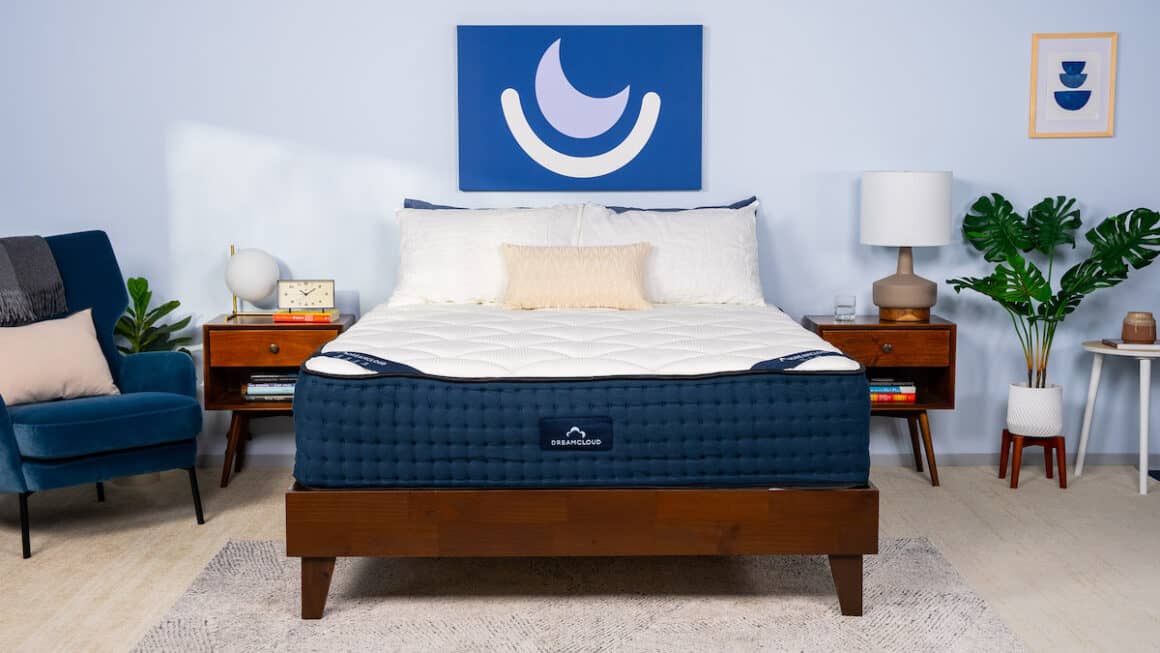

Ideal For
Combination Sleepers
Firmness
Medium Firm (6)
Feel
Cushioned, Supportive Surface
Value
Great Value
Pros & Cons

-
Pros
-
Hybrid construction with thick foam layers and a strong coil system
-
Excellent temperature regulation thanks to cooling cashmere-blend cover and steady airflow
-
365 night trial period
-
-
Cons
-
Too thick and adaptive for some stomach sleepers
-
Foam may sink and hinder movement across the surface
-
Our Take

The DreamCloud is a hybrid model featuring a comfort system with several foam layers. A layer of polyfoam is quilted into the breathable cashmere-blend cover, giving the surface a plush feel. Underneath is gel-infused memory foam that contours to the body and alleviates pressure. Transitional polyfoam prevents your body from sinking too deeply into the mattress. We found that the combination of responsive polyfoam and adaptive memory foam results in noticeable cushioning without a lot of sinkage.
Individually pocketed coils make up the support core. These coils reinforce the bed well, especially beneath the torso and hips, but we didn’t notice too much motion transfer during our motion isolation tests.
Why We Like It
The DreamCloud provides a comfortable, balanced feel thanks to its plush cushioning layers and a strong support system. Hot sleepers, couples, and people with back pain can all benefit from the luxury hybrid design. Since the mattress is medium firm (6), the highest ratings came from side and back sleepers on our team.
Standout Feature
Temperature control is another area where the DreamCloud performs well. This can be attributed to steady air circulation through the coils, as well as a breathable cashmere-blend cover that helps the surface stay cool. Our temperature sensors also picked up very little heat buildup.
Sleeper Type Ratings

The ratings below indicate how suitable this mattress is for different sleeping positions and sleeper weights, taking into account factors such as support and pressure relief.
Best Luxury Mattress
Saatva Classic
15% off orders of $1,000 or more
15% off orders of $1,000 or more
The Saatva Classic’s innovative coil-on-coil design delivers zoned support, reinforcing the midsection while gently cradling lighter areas of the body. The mattress is available in three firmness levels, and all customers receive free White Glove delivery and a 365-night trial.
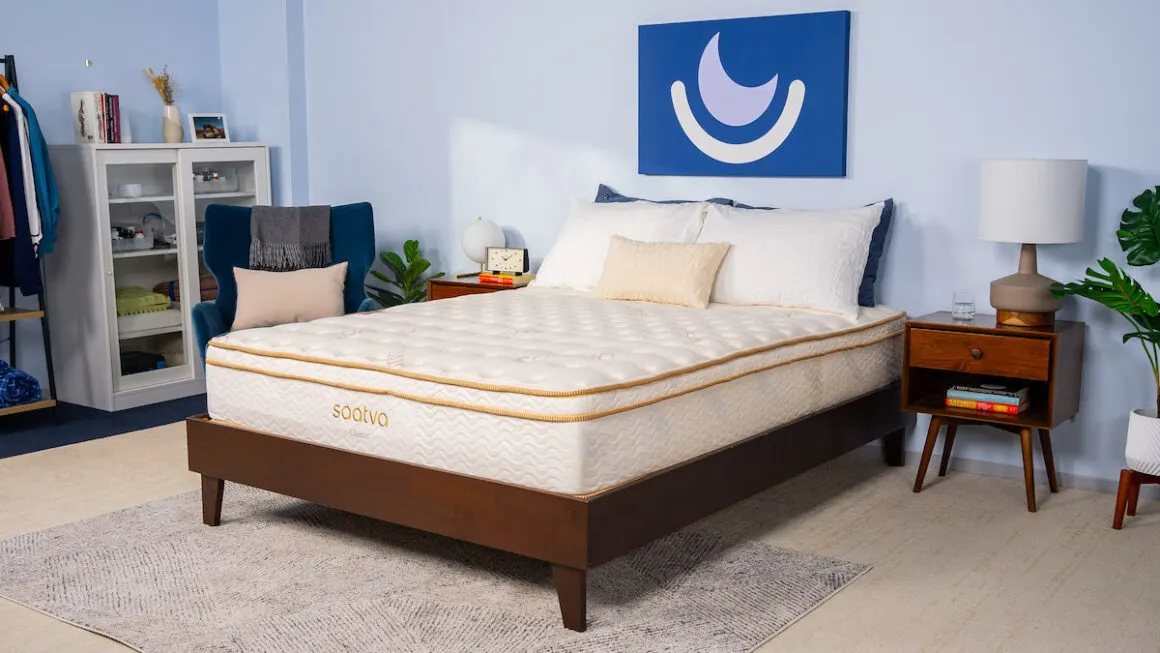

Ideal For
Back Sleepers
Firmness
Soft (3), Medium Firm (6), Firm (8)
Feel
Bouncy, Supportive Surface
Value
Fair Value
Pros & Cons

-
Pros
-
Coil-on-coil design ensures exceptional responsiveness and support
-
Mattress is available in three firmness levels and two profiles
-
Free White Glove delivery for all orders
-
-
Cons
-
Significant bounce limits motion isolation
-
May not provide enough contouring for side sleepers
-
Our Take

The Saatva Classic has a Euro-top padded with two foam layers, followed by a transitional layer of pocketed microcoils and a support core of robust, low-gauge hourglass coils made from recycled steel. Thanks to this “coil-on-coil” design, most of our testers noticed a fair amount of bounce that prevented them from sinking or feeling stuck as they moved across the mattress. We also noticed very little roll-off when testing the bed for perimeter support by lying and sitting along the edges. This was especially true for the Classic’s firmest, tallest design.
Why We Like It
Thanks to its innovative coil-on-coil construction, the Saatva Classic is well suited to people looking for a bouncy, supportive mattress that won’t sink too much beneath their weight. Free White Glove delivery should also incentivize those who would rather not set up a new mattress on their own. Couriers drive the mattress directly to your residence, assemble it in a room of your choice, and remove your old mattress or box spring upon request. This type of delivery service usually starts at $150, so you may want to go this route if you need help setting up your new mattress — the Saatva Classic is pretty heavy.
Sleeper Type Ratings

Best Mattress for Side Sleepers
Nolah Evolution 15
35% off sitewide + 2 free pillows with mattress purchase
35% off sitewide + 2 free pillows with mattress purchase
The Nolah Evolution 15 offers excellent cushioning thanks to thick foam layers on the surface, while the sturdy coils ensure plenty of pushback. It’s a perfect design for side sleepers seeking a balance of cradling and support.


Ideal For
Most Sleepers
Firmness
Medium (5) Medium Firm (6), Firm (8)
Feel
Plush, Supportive
Value
Good Value
Pros & Cons

-
Pros
-
Thick foam layers excel at cushioning and pressure relief
-
Three firmness options
-
Sturdy coils and zoned design deliver support for the lower back
-
-
Cons
-
You may need to purchase deep pocket sheets to accommodate the bed’s thick profile
-
Foam layers may off-gas for a few days after unboxing
-
Our Take

The Nolah Evolution is available in three firmness levels that correspond to medium (5), medium firm (6), and firm (8) on our test lab’s firmness scale.
The foam layers may absorb some heat, but air circulation through the coils and a cooling fabric in the cover both helped offset this heat retention. The Nolah Evolution 15 is a good choice for side sleepers who enjoy the hug of foam but tend to overheat on all-foam beds.
Why We Like It
We’ve tested many hybrid beds, but this model stands out with exceptionally thick foam layers on top and a substantial 15-inch profile. The quilted Euro-top cradles your body and is followed by adaptive polyfoam layers, all of which conform closely to your body and alleviate pressure points. A support core of coils is designed with three zones to further enhance pressure relief where it’s needed most. The perimeter is lined with reinforced coils to boost edge support.
Scoring & Details

The ratings below indicate how suitable this mattress is for different sleeping positions and sleeper weights, taking into account factors such as support and pressure relief.
Best Mattress for Couples
Brooklyn Bedding Signature Hybrid
25% off sitewide with code: SUMMER25
25% off sitewide with code: SUMMER25
The Brooklyn Bedding Signature Hybrid is a foam hybrid model that comes in three firmness levels. Even though each option has a different feel, they all offer strong cushioning for sore or achy joints. The optional cooling pillow-top is worth the splurge for those who lose lots of sleep from overheating.
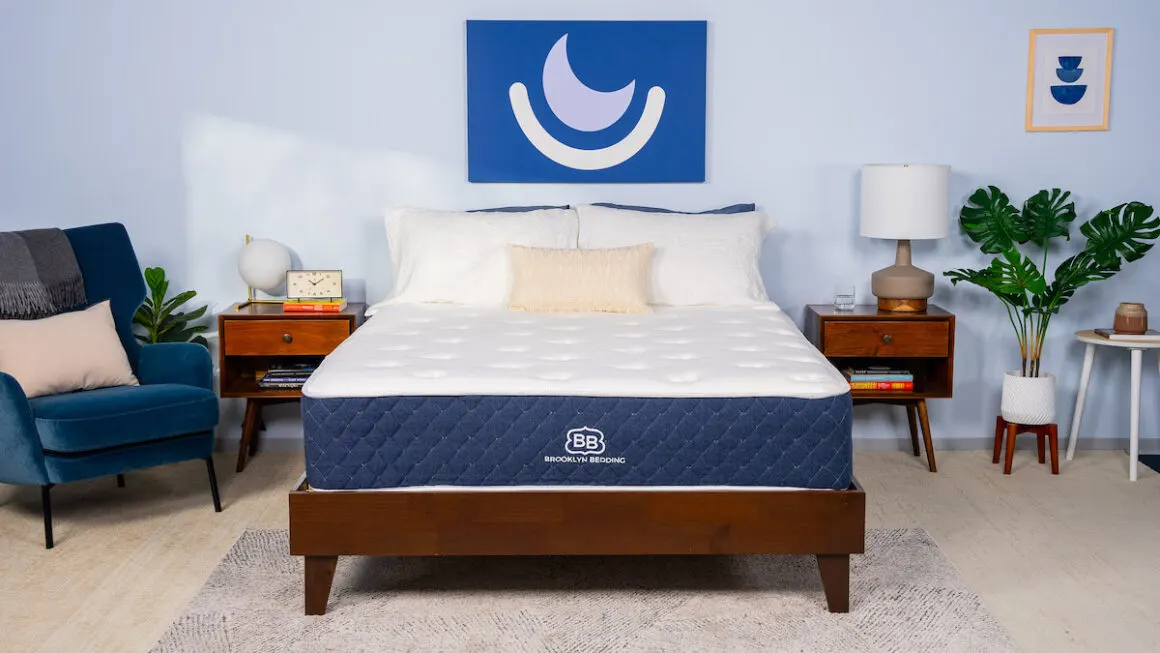
Ideal For
All Sleep Positions
Firmness
Medium Soft (4), Medium Firm (6), Firm (8)
Feel
Varies by Firmness
Value
Great Value
Pros & Cons

-
Pros
-
Triple foam comfort layers ensure cushioning and pressure relief
-
Three firmness options
-
Available in over a dozen sizes, including RV sizes
-
-
Cons
-
Some sleepers may notice off-gassing odors at first
-
Returns incur a $99 fee
-
Our Take

All Signature Hybrid models consist of three polyfoam layers with a plush quilted surface. The density and thickness of each foam layer varies between firmness options, but you’ll always feel cushioning and cradling after climbing into bed. Variflex transitional foam has a slightly responsive feel to keep your body from sinking too deep, and the thick coil core ensures plenty of support.
Why We Like It
The Brooklyn Bedding Signature Hybrid comes in three firmness options — medium soft (4), medium firm (6), and firm (8) — and we found pressure relief was a standout feature across all models. The foam layers cradled our bodies to minimize pressure buildup, and we were also impressed by the foam’s strong motion isolation in the two softer models. If your sleep is frequently disrupted by a restless partner, this feature can be a real asset.
Standout Feature
One standout feature of the Brooklyn Bedding Signature Hybrid is the optional pillow-top with a GlacioTex cooling cover, which is a phase change material engineered to regulate temperature on the surface. Although the cooling component costs extra, it may be a lifesaver for hot sleepers looking to offset heat retention from the foam layers.
Sleeper Type Ratings

Best Mattress for Back Pain
Bear Elite Hybrid
35% off + free pillows with code: SF35
35% off + free pillows with code: SF35
The Bear Elite Hybrid’s balanced design offers robust support and even cushioning to alleviate pressure-induced pain in the hips. Cooling materials in the cover and top layers also make the mattress resistant to heat retention.

Ideal For
Hot Sleepers
Firmness
Medium (5), Medium Firm (6), Firm (8)
Feel
Plush, Supportive Surface
Value
Good Value
Pros & Cons

-
Pros
-
Mixed-foam comfort system delivers even contouring
-
Cover made with Celliant and phase change material engineered to sleep cool
-
Three firmness options
-
-
Cons
-
Foam layers may off-gas initially
-
Softer models offer less edge support
-
Our Take

The Elite Hybrid is available in medium (5), medium firm (6), and firm (8) options. All models begin with a top layer of memory foam that contours to the body to alleviate pressure while ensuring your weight is evenly distributed across the surface. This layer is also infused with copper meant to reduce heat buildup. Transitional polyfoam adds a bit of extra cushioning and prevents your body from sinking too deeply into the support core. Pocketed coils make up the core, offering targeted support to prevent uncomfortable sinkage. A perimeter reinforcement helps the mattress bear your weight along the edges. The coils rest on a polyfoam base layer to prevent shifting. A breathable quilted cover encases the mattress, giving the surface a plush initial feel. The cover is made with Celliant and phase change material (PCM), both engineered to maintain a neutral temperature on the surface.
Why We Like It
Most of us agreed that the Bear Elite Hybrid’s foam hybrid design makes it a great choice for sleepers seeking a supportive mattress with even cushioning for pressure points. The medium option earned the highest ratings from back and side sleepers under 130 pounds since these sleepers need ample cushioning for the shoulders, hips, and spine. The medium firm option was best suited to side sleepers who weighed at least 130 pounds and back sleepers up to 230 pounds, while the firm performed best for side and back sleepers over 230 pounds and most stomach sleepers. Cooling was one of the Elite Hybrid’s most notable strengths. The Celliant and PCM cover and steady airflow through the coils kept our hot sleepers comfortable throughout testing. Our sensors detected minimal heat buildup.
Sleeper Type Ratings

The ratings below indicate how suitable this mattress is for different sleeping positions and sleeper weights, taking into account factors such as support and pressure relief.
Best Mattress for Hot Sleepers
PlushBeds Botanical Bliss
$1,250 off + free bedding credit at Plushbeds
$1,250 off + free bedding credit at Plushbeds
With three profiles and two firmness options to pick from, the PlushBeds Botanical Bliss is one of the most customizable models on this list. The latex design gently cradles the body while delivering excellent support, with a wool layer for added cushioning.


Ideal For
Hot Sleepers
Firmness
Medium Firm (6), Firm (7)
Feel
Responsive Latex
Value
Fair Value
Pros & Cons

-
Pros
-
Available in three profiles and two firmness options
-
Latex and wool design balances gentle contouring with sturdy support
-
Carries GOLS, GOTS, and GREENGUARD Gold certifications to ensure organic sourcing
-
-
Cons
-
Sleepers with a latex allergy may experience sensitivity
-
Heavy design can make the mattress difficult to lift alone
-
Our Take

You can choose between three heights — 9 inches, 10 inches, or 12 inches — as well as medium firm (6) or firm (7) feels. Each version begins with a soft and breathable organic cotton cover and a layer of organic wool. Both materials naturally wick away heat and moisture, helping you stay cool and dry. This is followed by a layer of Talalay latex that balances contouring with subtle bounce. The thick support core is composed of one to two layers of Dunlop latex, depending on the height. Dunlop is firmer and denser than Talalay latex.
Why We Like It
The PlushBeds Botanical Bliss combines organic latex and other eco-friendly materials to deliver personalized comfort and support. With a choice of two firmness levels and the added assurance of PlushBeds’ comfort exchange program, the mattress is a comfortable choice for a wide range of sleepers. The mattress holds certifications from GOTS, GOLS, and GREENGUARD Gold, indicating that the materials comply with certain safety and environmental standards.
Standout Feature
One of the standout features of this mattress is PlushBeds’ 100-night comfort exchange program, which lets you order an additional comfort layer if you decide your initial mattress purchase is too soft or firm.
Sleeper Type Ratings

The ratings below indicate how suitable this mattress is for different sleeping positions and sleeper weights, taking into account factors such as support and pressure relief.
Best Mattress for Combination Sleepers
Nest Bedding Sparrow
Check Price at Nest Bedding
Check Price at Nest Bedding
Available in three firmness levels and dual-firmness settings for king and California king sizes, the Nest Bedding Sparrow isolates motion, feels supportive along the perimeter, and sleeps cool. All of these qualities make the mattress particularly well-suited to couples.
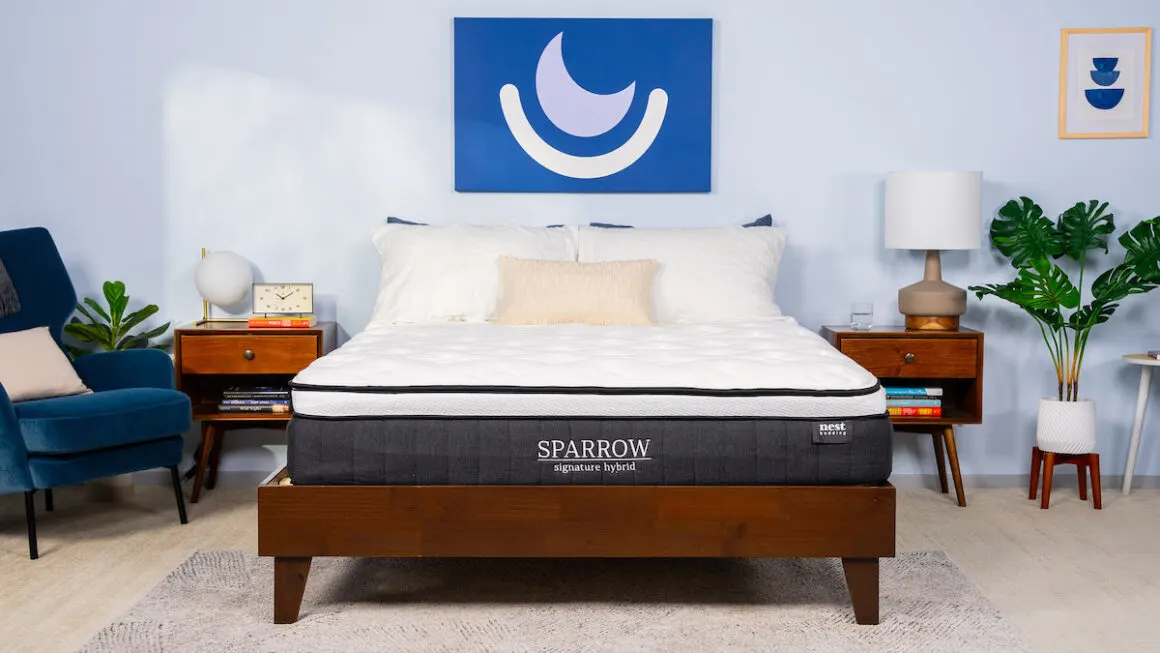
Ideal For
Couples
Firmness
Soft (3), Medium (5), Firm (7)
Feel
Close-Conforming Foam
Value
Good Value
Pros & Cons

-
Pros
-
Three firmness options
-
Foam comfort system excels at pressure relief
-
Thick foam layers reduce motion transfer
-
-
Cons
-
Foam layers trap body heat
-
May feel too adaptive for stomach sleepers
-
Our Take

The Sparrow is designed with three layers of foam over a 6-inch coil system. A top memory foam layer closely cradles your body, followed by a polyfoam Energex layer with a responsive feel and another polyfoam layer with enhanced support. The Energex layer varies in firmness depending on the model you choose, but our testers found that all three models offer a well-cushioned surface.
Why We Like It
The Sparrow is available in three different firmness options – soft (3), medium (5), and firm (7) – but during tests, the firm model earned high marks from many of our testers, especially back and side sleepers over 130 pounds. Side sleepers up to 230 pounds and back sleepers up to 130 pounds enjoyed the medium model. The soft model earned good reviews from side sleepers up to 130 pounds, but side sleepers in heavier weight categories may prefer a firmer option.
Standout Features
Some heat buildup is to be expected for beds with foam comfort systems, but the Sparrow felt temperature-neutral for many of our testers – even those who normally sleep hot. Phase change material infused into the cover offsets heat retention. Meanwhile airflow through the coil system helps ventilate the mattress to keep it cool.
Thanks to the thick foam comfort system, the mattress excelled at motion isolation tests in our sleep lab. This means you’ll feel very little motion transfer when your sleep partner shifts in the middle of the night. The bed also offers excellent pressure relief, especially in the soft and medium models. This appealed to testers who typically experience pressure buildup in the shoulders, hips, or spine.
Sleeper Type Ratings

The ratings below indicate how suitable this mattress is for different sleeping positions and sleeper weights, taking into account factors such as support and pressure relief.
Best Eco-Friendly Mattress
Avocado Eco Organic Mattress
Save up to $800 at Avocado
Save up to $800 at Avocado
The Avocado Eco Organic Mattress is firm, responsive, and highly supportive. Our tests show these qualities are particularly helpful if you primarily sleep on your stomach. The mattress’ sticker price is also well below-average for a latex hybrid.
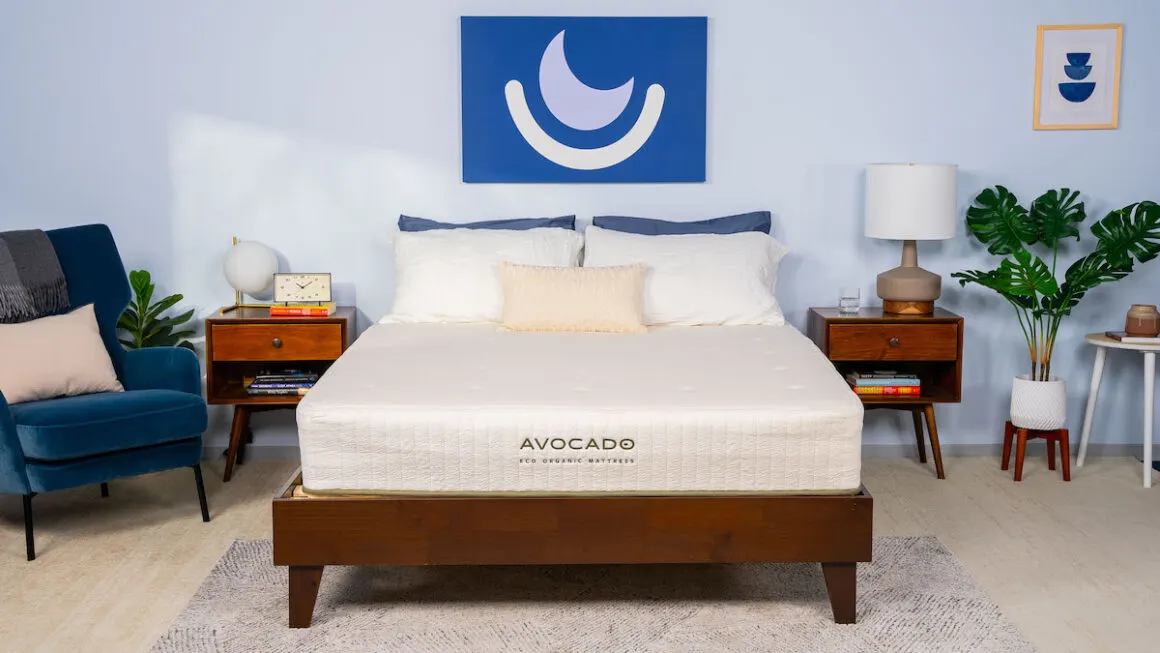
Ideal For
Stomach Sleepers
Firmness
Medium Firm (6)
Feel
Responsive Latex
Value
Fair Value
Pros & Cons

-
Pros
-
Eco-friendly components include sustainably sourced cotton, wool, and latex
-
Latex hybrid design is naturally durable, responsive, and breathable
-
Exceptional cooling and moisture control
-
-
Cons
-
Minimal contouring and limited pressure relief
-
Too bouncy to fully isolate motion
-
Our Take

The Eco Organic Mattress is medium firm (6) and our testers noted gentle cushioning, robust support, and easy movement across the surface. The mattress was especially popular with the stomach sleepers on our testing crew. The latex comfort layer is firm and responsive compared to memory foam, so deep sinkage was not an issue, and zoned coils deliver some much-needed support around the midsection. Temperature control is another strong point. We detected very little heat buildup on the surface, and the mattress slept cooler than the majority of foam beds we’ve tested. The latex is ventilated and the coils promote steady airflow, so there is plenty of circulation to help the interior of the mattress stay cool. The organic cotton cover and wool fire barrier are both breathable as well, and the wool wicks moisture away from the body on humid nights.
Why We Like It
The Avocado Eco Organic Mattress should meet the needs of any stomach sleeper seeking a firm, supportive, and responsive sleep surface. Hot sleepers should enjoy the breathable components of this latex hybrid design. Avocado has also earned a reputation for sleep products made mostly or entirely from sustainable materials. The latex, cotton, and wool have all been certified as organic. The company also used offset projects to achieve carbon negative shipping. Even the wrapping paper in the mattress delivery box is produced through eco-friendly means. While many latex hybrids – including most Avocado models – are on the expensive side, the Eco Organic Mattress is modestly priced for shoppers with tight budgets.
Sleeper Type Ratings

The ratings below indicate how suitable this mattress is for different sleeping positions and sleeper weights, taking into account factors such as support and pressure relief.
Dr. Breus On Choosing The Right Bed For You
Best Mattress Overall
Helix Midnight
Up to 30% off + 2 free pillows
SHOP NOWA solid choice for most sleepers thanks to consistent cooling, striking design, and affordable pricing.
SEE MORE DETAILS
Most Comfortable Mattress
Luxury Firm WinkBed
Get $300 off all mattresses at Winkbeds
SHOP NOWA reliably comfortable mattress that performs well in areas where hybrids often fall short.
SEE MORE DETAILS
Best Value Mattress
DreamCloud Mattress
Up to 50% off at DreamCloud
SHOP NOWA luxury hybrid with an accessible sticker price.
SEE MORE DETAILS
Best Luxury Mattress
Saatva Classic
15% off orders of $1,000 or more
SHOP NOWA bouncy and supportive mattress that provides excellent support.
SEE MORE DETAILS
Best Mattress for Side Sleepers
Nolah Evolution 15
35% off sitewide + 2 free pillows with mattress purchase
SHOP NOWExtra thick comfort layers relieve pressure points, but offer plenty of support.
SEE MORE DETAILS
Best Mattress for Couples
Brooklyn Bedding Signature Hybrid
Best Mattress for Back Pain
Bear Elite Hybrid
35% off + free pillows with code: SF35
SHOP NOWA great choice for sleepers seeking a supportive mattress with even cushioning for pressure points.
SEE MORE DETAILS
Best Mattress for Hot Sleepers
PlushBeds Botanical Bliss
$1,250 off + free bedding credit at Plushbeds
SHOP NOWOrganic latex and cotton sleep cool on the bouncy, supportive surface.
SEE MORE DETAILS
Best Mattress for Combination Sleepers
Nest Bedding Sparrow
Check Price at Nest Bedding
SHOP NOWA customizable, supportive, and cool hybrid for couples.
SEE MORE DETAILS
Best Eco-Friendly Mattress
Avocado Eco Organic Mattress
Save up to $800 at Avocado
SHOP NOWA firm, supportive, and responsive sleep surface made from certified materials.
SEE MORE DETAILS
Why You Should Trust Us
Getting a good night’s sleep is hard enough without having to worry about things like foam density and coil tension. With that in mind, renowned sleep doctor Dr. Michael J. Breus has worked with our product testing team to toil over 4,000+ sleep products (including 1,934 mattresses) in our Seattle-based Test Lab over the past eight years so sleepers like you can rest easier.
What we’ve learned has dictated how and why we test what we do, what we look for in a bed and a bed company, and which tools and products can ultimately lead to better sleep.
As sleep science and product experts, we find joy in taking products home to sleep on, monitoring real-time sleep data, and staying current on the science of sleep health and sleep-tech trends to provide data-backed recommendations you can trust.
In our Test Lab we monitor things like heat retention, motion isolation, and pressure maps, and you’ll also see sleep-health experts like Dr. Breus drop by to adjust a firmness rating or offer tips on syncing the sleep environment with sleep hygiene.
Our goal at the Test Lab is to take the guesswork out of your sleep journey to lull you into your best-slept self, because better days ahead start with better sleep.
Testing Criteria
Mattress comfort is highly subjective and largely based on body weight and sleep position. Our recommendations are based on feedback from testers who side sleep, back sleep, and stomach sleep across three different weight groups: less than 130 pounds, 130 to 230 pounds, and more than 230 pounds. Our testing process looks at data points across design and performance elements across, including:
Motion Isolation
A mattress with great motion isolation absorbs movement on one side of the bed and prevents it from transferring to the other– It’s a quality that’s important, especially to people who share a bed with a partner. To test for motion isolation, two testers lie side-by-side on a mattress and feel for movement. Then we compress the mattress with kettlebells to measure impact and situate a container of water at the end of the mattress to evaluate surface stability. Our in-home testers then measure waves of movement on the mattress using vibration-sensing technology.
Temperature Neutrality
This performance category refers to how well a mattress maintains a comfortable temperature. To measure heat absorption, we begin with the “hot bottle test,” during which we place a heated thermos on the mattress and record how long it takes for the heat to dissipate, relying on thermal technology to measure heat buildup on the mattress surface. Testers of varying weights also take turns lying on the mattress in different positions to see if the mattress sleeps too warm for side, back, or stomach sleepers.
Pressure Relief
People experience pressure build up in areas like the hips and shoulders due to uneven spinal alignment and lack of support. A mattress can either reduce or worsen these pressure points. To test for pressure relief, our testers take turns lying down on a mattress in different positions to see if they experience pressure in the shoulders, back, or hips. We can see this via body-mapping sensors, which use color-coded imaging to display areas of the body where pressure buildup occurs.
Edge Support
To determine whether a mattress feels stable along the edges, we conduct a series of tests that mimic everyday movements. These include lying in the middle of the mattress and rolling toward the edge, sitting along the perimeter to tie shoes, and getting in and out of bed. While this happens, we measure how much compression occurs along the edges and how well the perimeter recovers after the weight is removed. This is also known as the “press test.”
Ease of Movement
A mattress with a responsive, springy surface is usually easier to move across than one that sinks beneath your weight. We test ease of movement by first asking testers to crawl across the mattress, pressing as deeply as possible to gauge how restrictive the surface is. We also place kettlebells in the center, then time how long the surface needs to recover its full shape.
Odor Emissions
Most new mattresses emit chemical odors after unboxing, but certain materials are associated with stronger odors. After unboxing each mattress that arrives in our lab, we set a timer and use a subjective “smell test” to evaluate these odors at intervals of 10 minutes, one hour, three hours, and 24 hours. Most of these odors come from the volatile organic compounds (VOCs) found in synthetic foam. Using a VOC meter, we measure the concentration of these compounds in the room relative to a room with normal VOC levels.
Finding the Right Mattress for Your Needs
Every sleeper’s needs are different and a sleep system can take many forms. A combination of variables, from sleep position to the loft of your pillow and what type of sheets you use can contribute to the quality of your sleep.
Use the categories and watch the video below to narrow down your mattress search according to your specific needs. Want to dive deeper into mattress materials, care, and shopping? Explore our collection of mattress guides.
